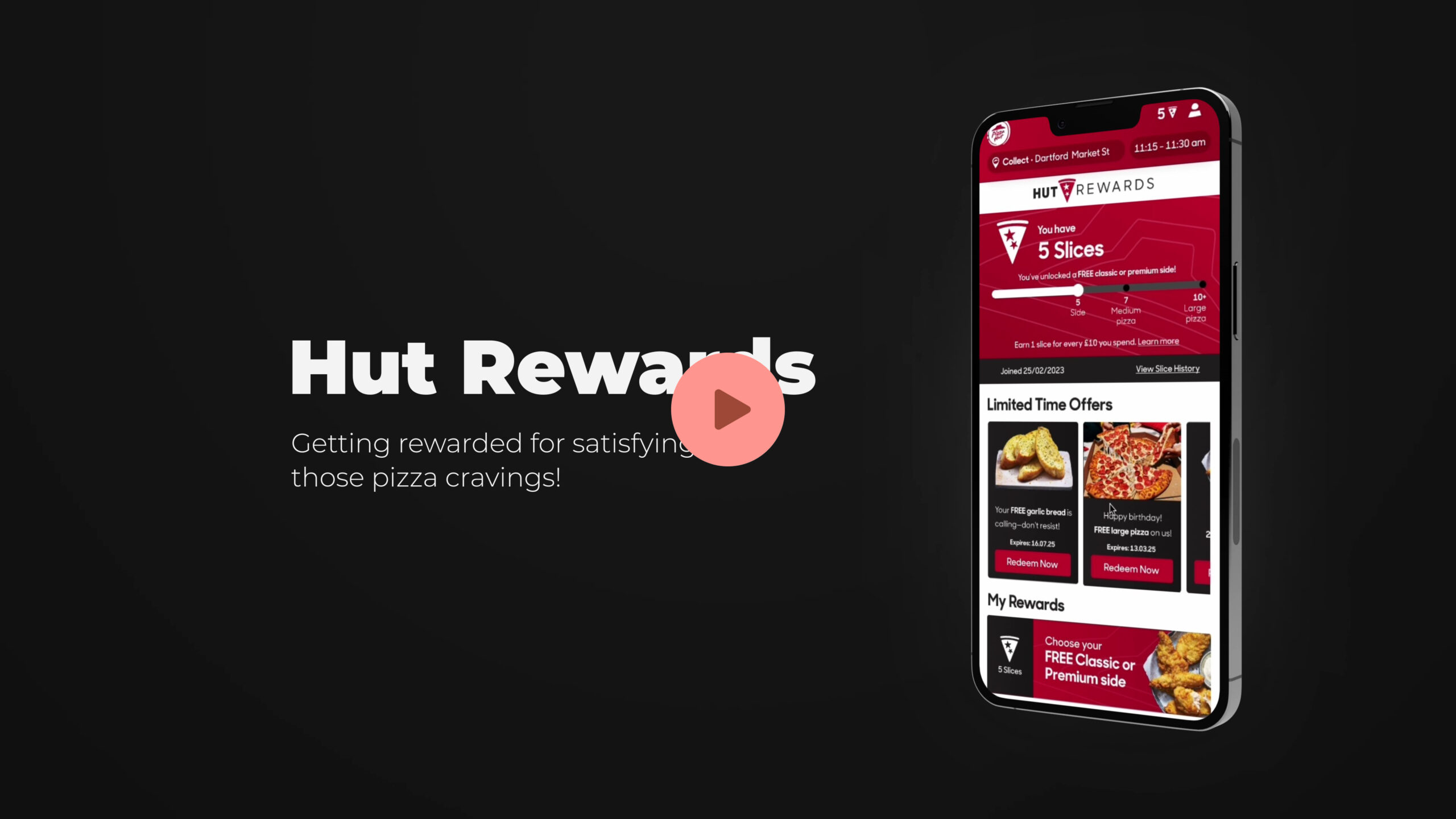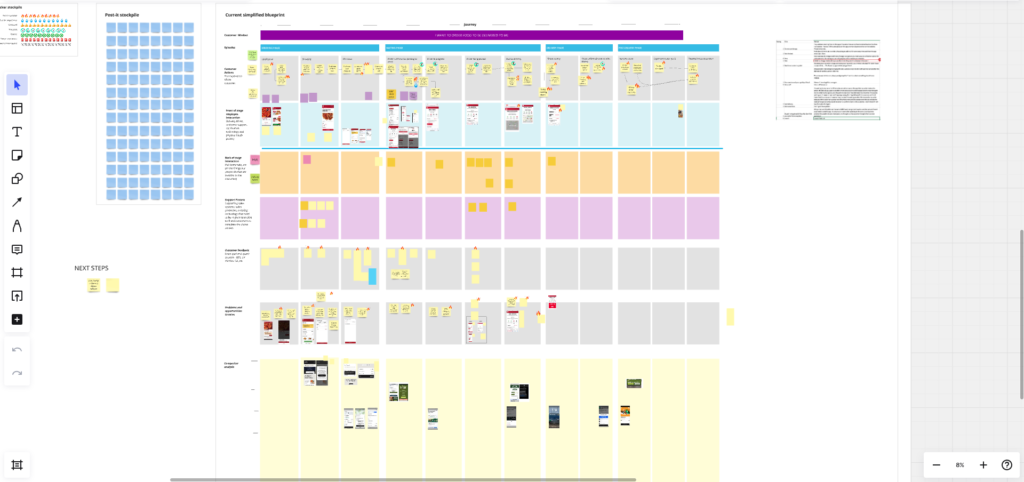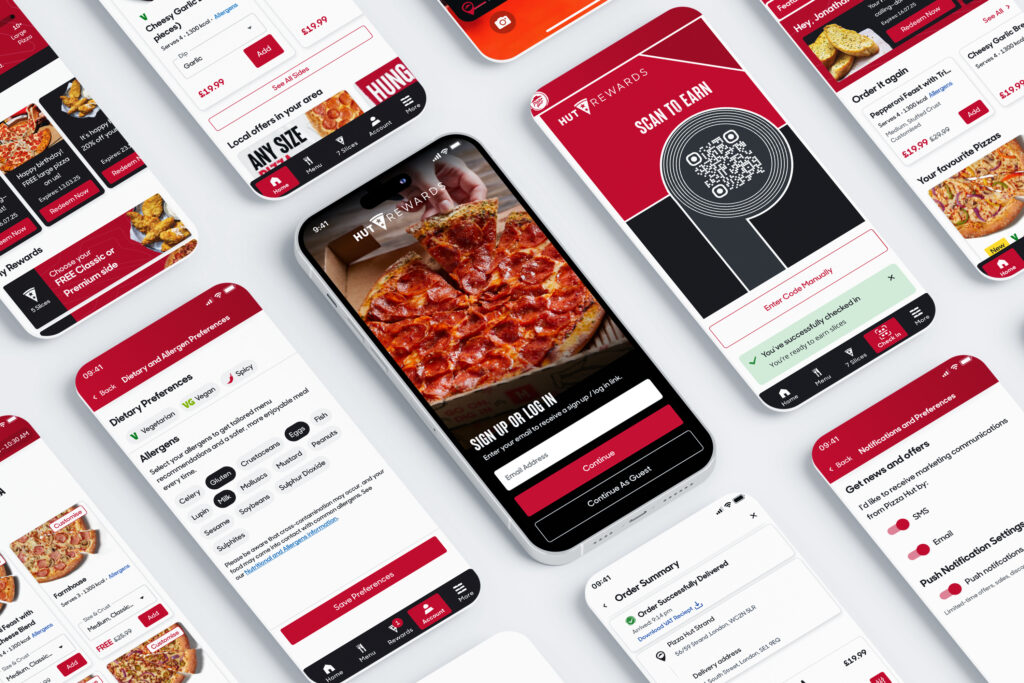Encourage people to give different answers to the clearly defined problem, seeking inspiration from elsewhere and co-designing with a range of different people.
My team and I collaborated with other squads to brainstorm several vital components that would work together to create a truly personalised and scalable solution.
a) Personalised web experience that would set the foundations for a new App: I spearheaded the web redesign, creating a user-friendly interface that could adapt to individual customer preferences. This provided a seamless ordering experience and offered personalised recommendations, making it easier for customers to find their favourite Pizza.
I assigned the junior designer on my team to research best practices in mobile app UI/UX, and they came back with some great benchmark examples from leading food delivery apps.
Together, we ideated on ways to implement AI/ML-driven personalised recommendations. The junior designer led the wireframing of the "Pizza Profile" feature, where customers can customise their preferences. I guided ensuring smooth integration with the backend systems to deliver accurate recommendations.
b) Simplified Loyalty Program Revamping the loyalty program was a critical piece of the puzzle. I knew we needed to make it more intuitive and rewarding for customers. I tasked the junior designer with benchmarking competitor loyalty programs and presenting their findings. Based on that research, we collaborated on the membership structure and the reward redemption mechanism.
I took a hands-on approach in designing the progress bar and worked with the PM to define exclusive benefits. This was an area where I could leverage gamification and behavioural psychology to create a program that would truly engage customers.
c) Omnichannel Experience: Ensuring a consistent experience across all customer touchpoints is essential for building brand loyalty. I worked closely with the product managers, market stakeholders, and engineering team to map the customer journey, create a service blueprint, and identify seamless integration points between the mobile app, website, and in-store interactions.
I assigned the junior designer to explore innovative solutions like QR code scanning for in-store ordering.
As the lead designer, I understood the paramount importance of data-driven decision-making. I collaborated with the data science team to conceptualise the centralised customer data platform and the predictive analytics capabilities, instilling confidence in our strategic approach.
e) Localisation Framework Ensuring global scalability was a key priority. I worked with the international expansion team to define the requirements for a flexible localisation framework. I assigned the junior designer to research successful global expansion case studies and present their findings.
We ideated on multi-language support, regional menu customisation, and loyalty programme variations.
Throughout this process, I provided mentorship and guidance to the junior designer, encouraging them to take ownership of specific tasks while also collaborating closely on the overall solution. Their fresh perspectives and innovative ideas complemented my experience, resulting in a comprehensive and scalable redesign of Pizza Hut UK's customer and loyalty experience.
Service Blueprinting Multi-modal Loyalty
A solution that delivers and measures customer value, business value and quality.
As the lead designer, I developed high-fidelity prototypes for our new mobile app and loyalty program web experiences.
I recognised the potential of our junior designer, Nat, and gave her a significant growth opportunity. I assigned her the task of designing the secondary screens and micro-interactions, and scheduled daily check-ins to review her work and offer guidance, fostering her professional development.
For usability testing, I developed a comprehensive test plan. I delegated the recruitment of test participants to Nat, providing her with criteria for selecting a diverse group of users. This gave her exposure to the importance of representative user testing.
I conducted the initial round of usability tests myself, with Nat observing. For subsequent sessions, I had Nat lead some tests under my supervision, offering feedback on her moderation techniques.
For A/B testing, I designed the main variants for our reward structures and personalisation experiences. I then tasked Nat with creating additional variations, challenging her to think critically about user motivations and behaviours.
As we moved into the implementation phase, my role shifted to liaison between the design and development teams. I led the handoff meetings, ensuring our design intentions were clearly communicated.
I oversaw the design QA process during the phased rollout in the UK. I showed Nat how to effectively communicate design issues to the development team, emphasising the importance of clear, constructive feedback.
As we approached the launch date, it became clear that our initial scope was ambitious, given our agreed launch date with the UK market. As the lead designer, I worked closely with our product team and senior leadership to prioritise features and identify items that could be pushed to the next delivery phase.
After thorough discussions with product managers and stakeholders, we decided to prioritise the following for the initial launch:
- The redesigned mobile app with basic personalisation
- The new loyalty program structure
- Essential omnichannel experiences (web, mobile, and in-store ordering integration)
We had to push several features to the next phase, including:
- Advanced AI-driven recommendations
- Dietary preferences
- Social media integration for logon
- Some aspects of the localisation framework
With our revised scope, I led the design handoff meetings, ensuring that our core design intentions were clearly communicated to the development team. I assigned Nat to create a prioritised list of design components, specifically the focus needed for our core functionality.
Results (3 months post-launch in UK):
- 25% increase in customer retention rate:
This significant improvement was primarily attributed our new end to end CX and to our new loyalty program. We saw a marked decrease in customer churn, particularly among casual users who were now more motivated to reach higher loyalty rewards. - 12% boost in loyalty program engagement:
The simplified tier system and more immediate rewards led to increased interaction with the loyalty program. - 15% increase in average order value:
This was an unexpected but welcome result. The app's personalized recommendations seemed to encourage users to try new menu items or add extras to their orders. - 10% improvement in customer satisfaction scores:
Our post-order surveys showed higher satisfaction across various touch points.







